Risk Management Report: Analysis of the ISS Project's Challenges
VerifiedAdded on 2020/10/22
|11
|2868
|325
Report
AI Summary
This report provides an in-depth analysis of risk management strategies employed for the International Space Station (ISS) project. It begins with an executive summary highlighting the importance of risk management in ensuring the success and sustainability of complex projects like the ISS. The introduction outlines the role of risk management in identifying and mitigating uncertainties, particularly for projects involving international collaboration, such as the ISS, a joint venture of multiple space agencies. The main body of the report details various aspects of risk management, including the identification of potential hazards like radiation exposure, stress, and the risk of meteoroid and orbital debris (MMOD) impacts. It further explores strategies such as continuous risk management and the delegation of risk management responsibilities. The report also covers operational, tactical, strategic, political, and financial risks. A disaster management plan is presented, emphasizing preparedness for technical, operational, and programmatic events, including budget allocation for unforeseen circumstances and the maintenance of an emergency management program. The conclusion summarizes the key findings, emphasizing the proactive approach to risk management as critical for the ISS project's continued success.
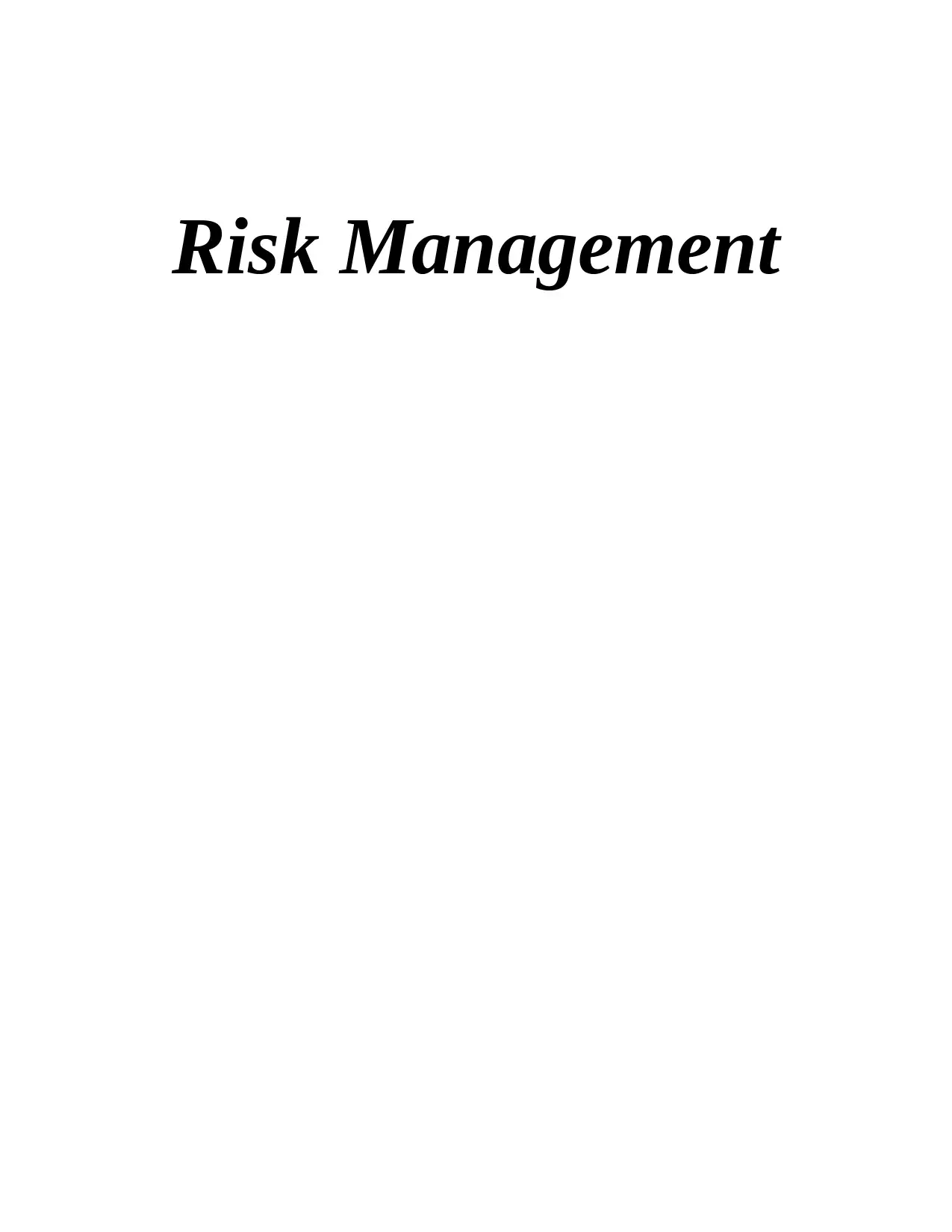
Risk Management
Paraphrase This Document
Need a fresh take? Get an instant paraphrase of this document with our AI Paraphraser
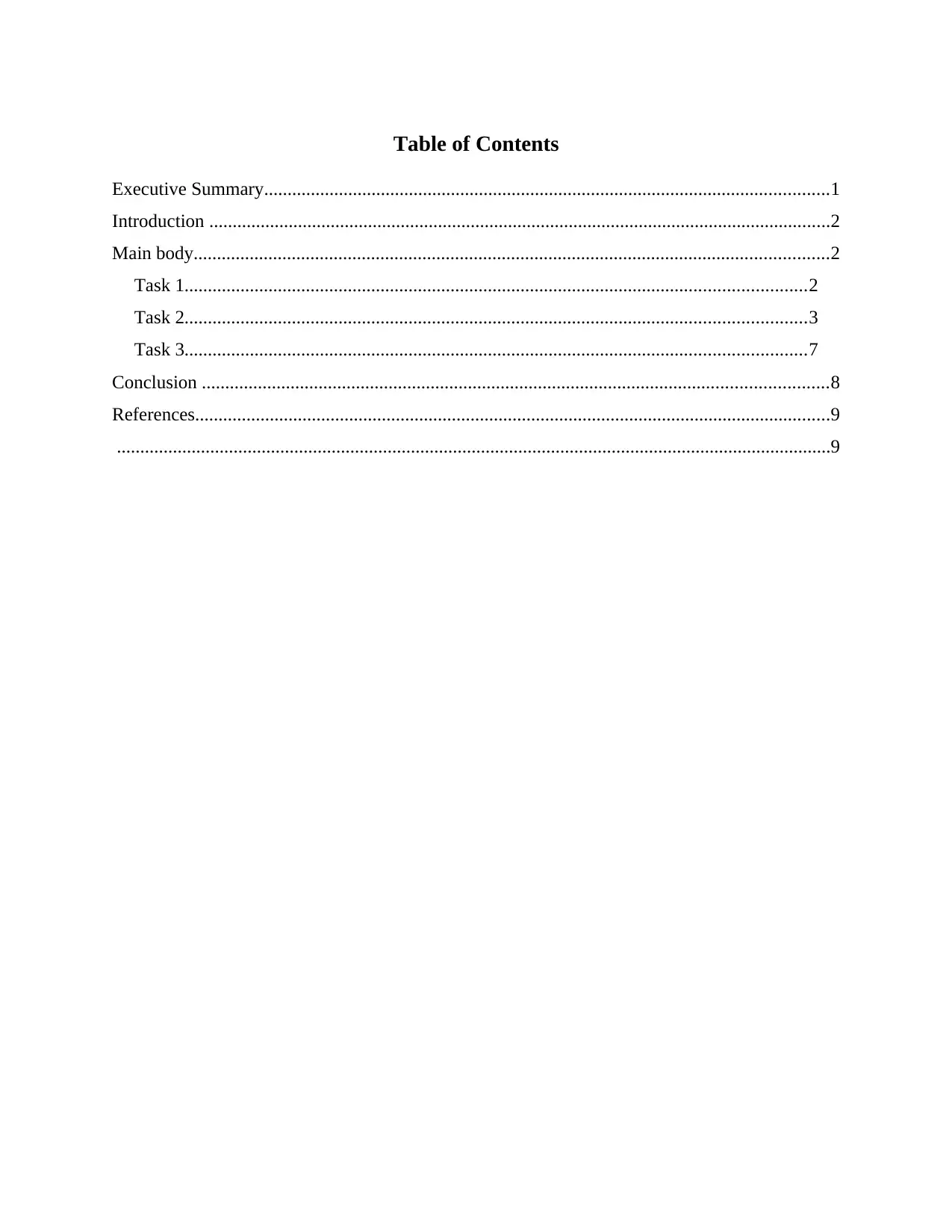
Table of Contents
Executive Summary.........................................................................................................................1
Introduction .....................................................................................................................................2
Main body........................................................................................................................................2
Task 1.....................................................................................................................................2
Task 2.....................................................................................................................................3
Task 3.....................................................................................................................................7
Conclusion ......................................................................................................................................8
References........................................................................................................................................9
.........................................................................................................................................................9
Executive Summary.........................................................................................................................1
Introduction .....................................................................................................................................2
Main body........................................................................................................................................2
Task 1.....................................................................................................................................2
Task 2.....................................................................................................................................3
Task 3.....................................................................................................................................7
Conclusion ......................................................................................................................................8
References........................................................................................................................................9
.........................................................................................................................................................9
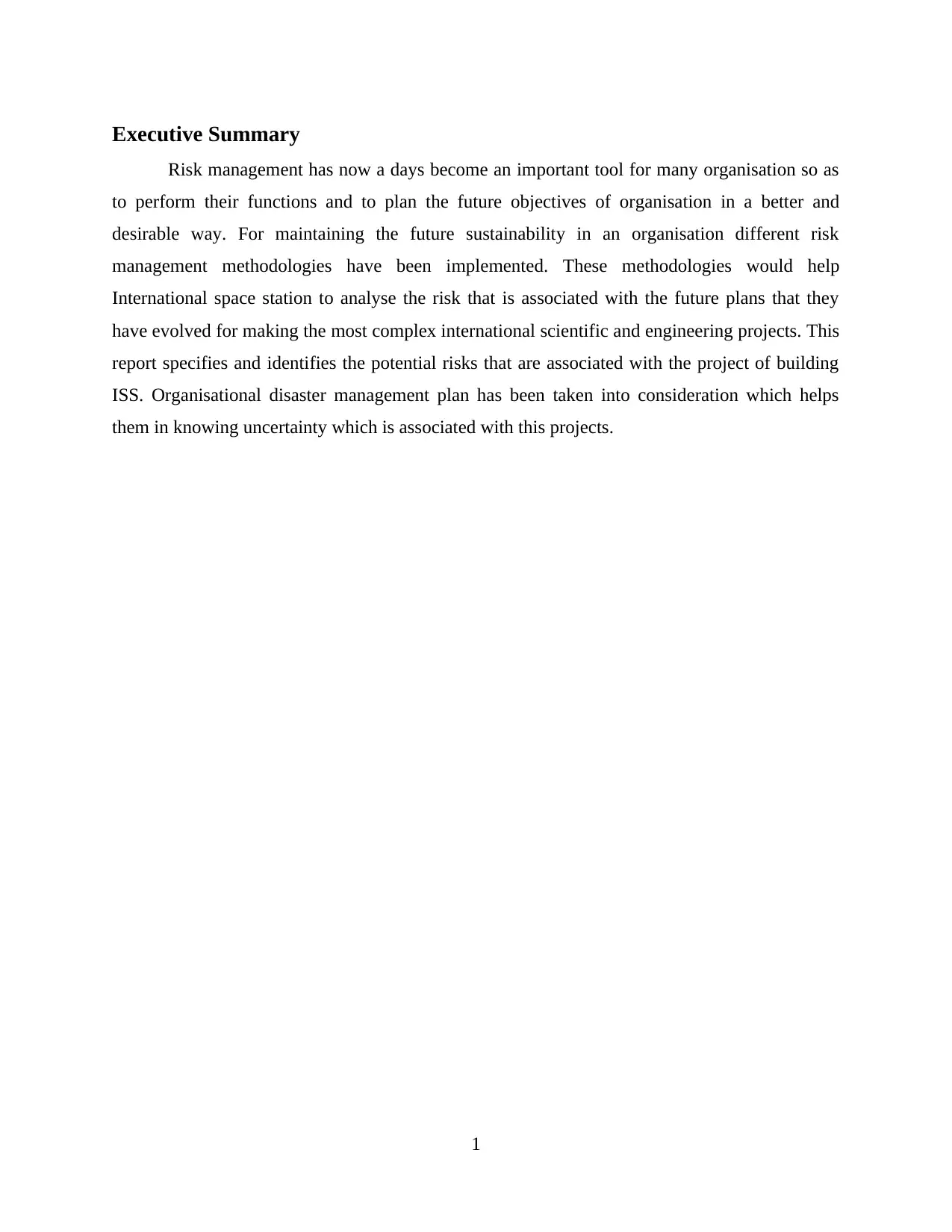
Executive Summary
Risk management has now a days become an important tool for many organisation so as
to perform their functions and to plan the future objectives of organisation in a better and
desirable way. For maintaining the future sustainability in an organisation different risk
management methodologies have been implemented. These methodologies would help
International space station to analyse the risk that is associated with the future plans that they
have evolved for making the most complex international scientific and engineering projects. This
report specifies and identifies the potential risks that are associated with the project of building
ISS. Organisational disaster management plan has been taken into consideration which helps
them in knowing uncertainty which is associated with this projects.
1
Risk management has now a days become an important tool for many organisation so as
to perform their functions and to plan the future objectives of organisation in a better and
desirable way. For maintaining the future sustainability in an organisation different risk
management methodologies have been implemented. These methodologies would help
International space station to analyse the risk that is associated with the future plans that they
have evolved for making the most complex international scientific and engineering projects. This
report specifies and identifies the potential risks that are associated with the project of building
ISS. Organisational disaster management plan has been taken into consideration which helps
them in knowing uncertainty which is associated with this projects.
1
⊘ This is a preview!⊘
Do you want full access?
Subscribe today to unlock all pages.

Trusted by 1+ million students worldwide
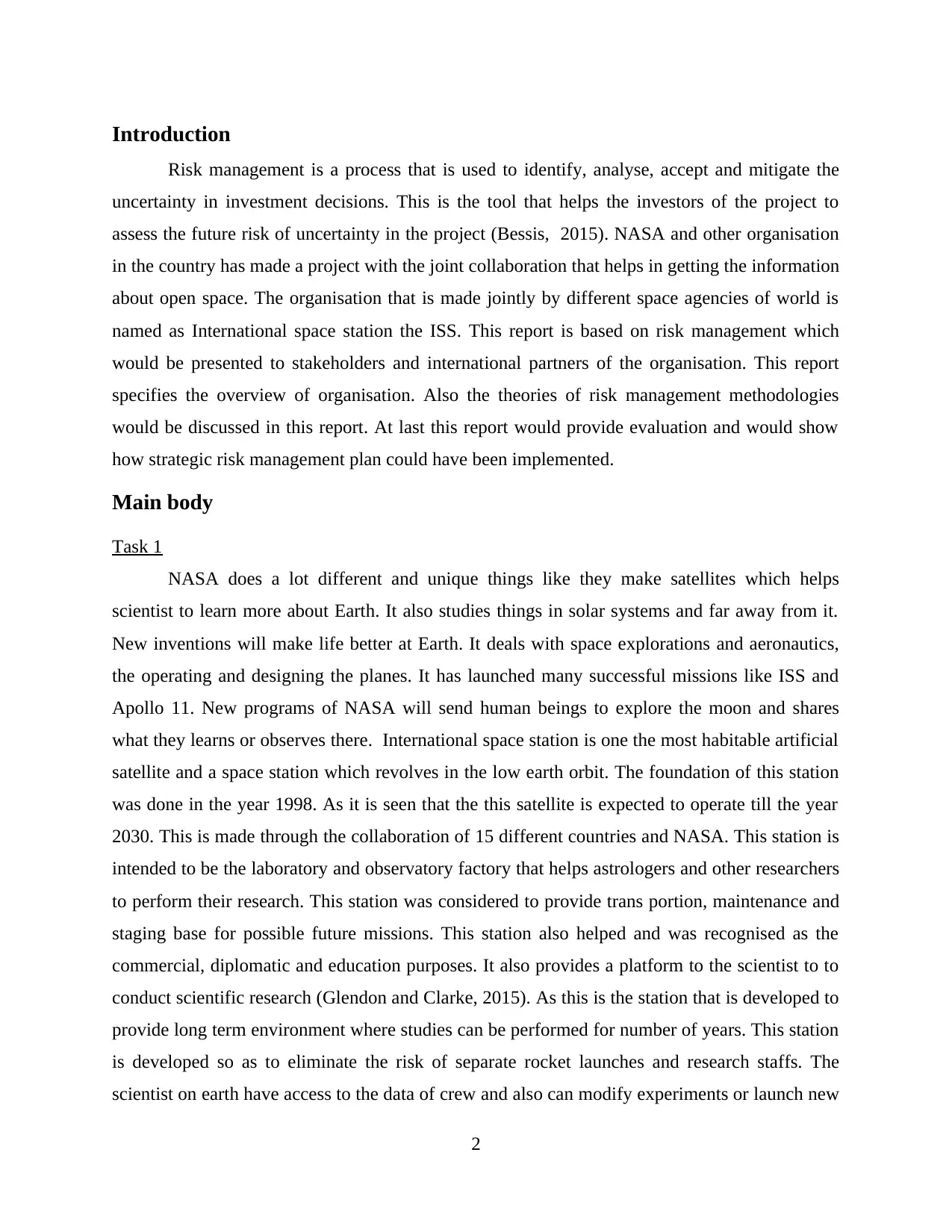
Introduction
Risk management is a process that is used to identify, analyse, accept and mitigate the
uncertainty in investment decisions. This is the tool that helps the investors of the project to
assess the future risk of uncertainty in the project (Bessis, 2015). NASA and other organisation
in the country has made a project with the joint collaboration that helps in getting the information
about open space. The organisation that is made jointly by different space agencies of world is
named as International space station the ISS. This report is based on risk management which
would be presented to stakeholders and international partners of the organisation. This report
specifies the overview of organisation. Also the theories of risk management methodologies
would be discussed in this report. At last this report would provide evaluation and would show
how strategic risk management plan could have been implemented.
Main body
Task 1
NASA does a lot different and unique things like they make satellites which helps
scientist to learn more about Earth. It also studies things in solar systems and far away from it.
New inventions will make life better at Earth. It deals with space explorations and aeronautics,
the operating and designing the planes. It has launched many successful missions like ISS and
Apollo 11. New programs of NASA will send human beings to explore the moon and shares
what they learns or observes there. International space station is one the most habitable artificial
satellite and a space station which revolves in the low earth orbit. The foundation of this station
was done in the year 1998. As it is seen that the this satellite is expected to operate till the year
2030. This is made through the collaboration of 15 different countries and NASA. This station is
intended to be the laboratory and observatory factory that helps astrologers and other researchers
to perform their research. This station was considered to provide trans portion, maintenance and
staging base for possible future missions. This station also helped and was recognised as the
commercial, diplomatic and education purposes. It also provides a platform to the scientist to to
conduct scientific research (Glendon and Clarke, 2015). As this is the station that is developed to
provide long term environment where studies can be performed for number of years. This station
is developed so as to eliminate the risk of separate rocket launches and research staffs. The
scientist on earth have access to the data of crew and also can modify experiments or launch new
2
Risk management is a process that is used to identify, analyse, accept and mitigate the
uncertainty in investment decisions. This is the tool that helps the investors of the project to
assess the future risk of uncertainty in the project (Bessis, 2015). NASA and other organisation
in the country has made a project with the joint collaboration that helps in getting the information
about open space. The organisation that is made jointly by different space agencies of world is
named as International space station the ISS. This report is based on risk management which
would be presented to stakeholders and international partners of the organisation. This report
specifies the overview of organisation. Also the theories of risk management methodologies
would be discussed in this report. At last this report would provide evaluation and would show
how strategic risk management plan could have been implemented.
Main body
Task 1
NASA does a lot different and unique things like they make satellites which helps
scientist to learn more about Earth. It also studies things in solar systems and far away from it.
New inventions will make life better at Earth. It deals with space explorations and aeronautics,
the operating and designing the planes. It has launched many successful missions like ISS and
Apollo 11. New programs of NASA will send human beings to explore the moon and shares
what they learns or observes there. International space station is one the most habitable artificial
satellite and a space station which revolves in the low earth orbit. The foundation of this station
was done in the year 1998. As it is seen that the this satellite is expected to operate till the year
2030. This is made through the collaboration of 15 different countries and NASA. This station is
intended to be the laboratory and observatory factory that helps astrologers and other researchers
to perform their research. This station was considered to provide trans portion, maintenance and
staging base for possible future missions. This station also helped and was recognised as the
commercial, diplomatic and education purposes. It also provides a platform to the scientist to to
conduct scientific research (Glendon and Clarke, 2015). As this is the station that is developed to
provide long term environment where studies can be performed for number of years. This station
is developed so as to eliminate the risk of separate rocket launches and research staffs. The
scientist on earth have access to the data of crew and also can modify experiments or launch new
2
Paraphrase This Document
Need a fresh take? Get an instant paraphrase of this document with our AI Paraphraser
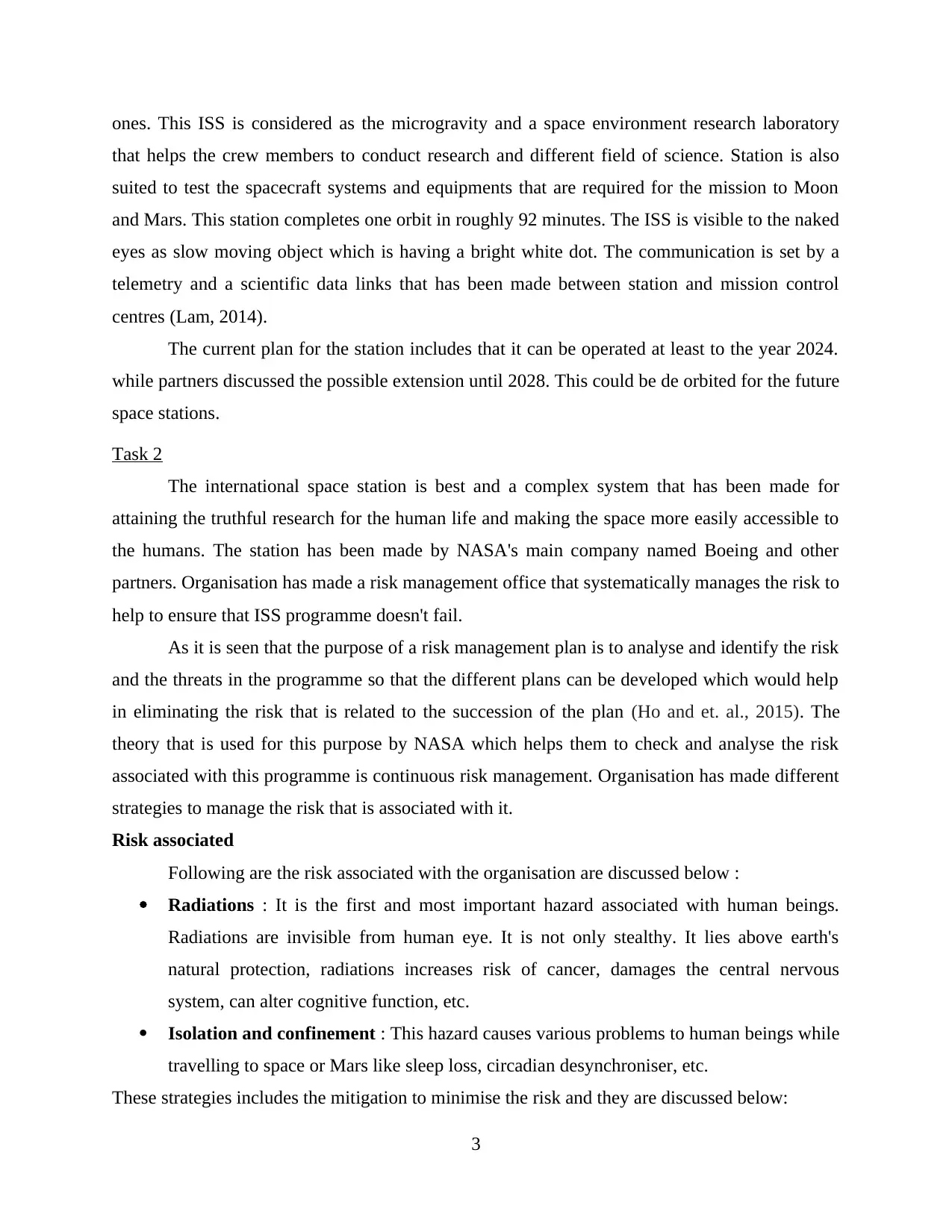
ones. This ISS is considered as the microgravity and a space environment research laboratory
that helps the crew members to conduct research and different field of science. Station is also
suited to test the spacecraft systems and equipments that are required for the mission to Moon
and Mars. This station completes one orbit in roughly 92 minutes. The ISS is visible to the naked
eyes as slow moving object which is having a bright white dot. The communication is set by a
telemetry and a scientific data links that has been made between station and mission control
centres (Lam, 2014).
The current plan for the station includes that it can be operated at least to the year 2024.
while partners discussed the possible extension until 2028. This could be de orbited for the future
space stations.
Task 2
The international space station is best and a complex system that has been made for
attaining the truthful research for the human life and making the space more easily accessible to
the humans. The station has been made by NASA's main company named Boeing and other
partners. Organisation has made a risk management office that systematically manages the risk to
help to ensure that ISS programme doesn't fail.
As it is seen that the purpose of a risk management plan is to analyse and identify the risk
and the threats in the programme so that the different plans can be developed which would help
in eliminating the risk that is related to the succession of the plan (Ho and et. al., 2015). The
theory that is used for this purpose by NASA which helps them to check and analyse the risk
associated with this programme is continuous risk management. Organisation has made different
strategies to manage the risk that is associated with it.
Risk associated
Following are the risk associated with the organisation are discussed below :
Radiations : It is the first and most important hazard associated with human beings.
Radiations are invisible from human eye. It is not only stealthy. It lies above earth's
natural protection, radiations increases risk of cancer, damages the central nervous
system, can alter cognitive function, etc.
Isolation and confinement : This hazard causes various problems to human beings while
travelling to space or Mars like sleep loss, circadian desynchroniser, etc.
These strategies includes the mitigation to minimise the risk and they are discussed below:
3
that helps the crew members to conduct research and different field of science. Station is also
suited to test the spacecraft systems and equipments that are required for the mission to Moon
and Mars. This station completes one orbit in roughly 92 minutes. The ISS is visible to the naked
eyes as slow moving object which is having a bright white dot. The communication is set by a
telemetry and a scientific data links that has been made between station and mission control
centres (Lam, 2014).
The current plan for the station includes that it can be operated at least to the year 2024.
while partners discussed the possible extension until 2028. This could be de orbited for the future
space stations.
Task 2
The international space station is best and a complex system that has been made for
attaining the truthful research for the human life and making the space more easily accessible to
the humans. The station has been made by NASA's main company named Boeing and other
partners. Organisation has made a risk management office that systematically manages the risk to
help to ensure that ISS programme doesn't fail.
As it is seen that the purpose of a risk management plan is to analyse and identify the risk
and the threats in the programme so that the different plans can be developed which would help
in eliminating the risk that is related to the succession of the plan (Ho and et. al., 2015). The
theory that is used for this purpose by NASA which helps them to check and analyse the risk
associated with this programme is continuous risk management. Organisation has made different
strategies to manage the risk that is associated with it.
Risk associated
Following are the risk associated with the organisation are discussed below :
Radiations : It is the first and most important hazard associated with human beings.
Radiations are invisible from human eye. It is not only stealthy. It lies above earth's
natural protection, radiations increases risk of cancer, damages the central nervous
system, can alter cognitive function, etc.
Isolation and confinement : This hazard causes various problems to human beings while
travelling to space or Mars like sleep loss, circadian desynchroniser, etc.
These strategies includes the mitigation to minimise the risk and they are discussed below:
3
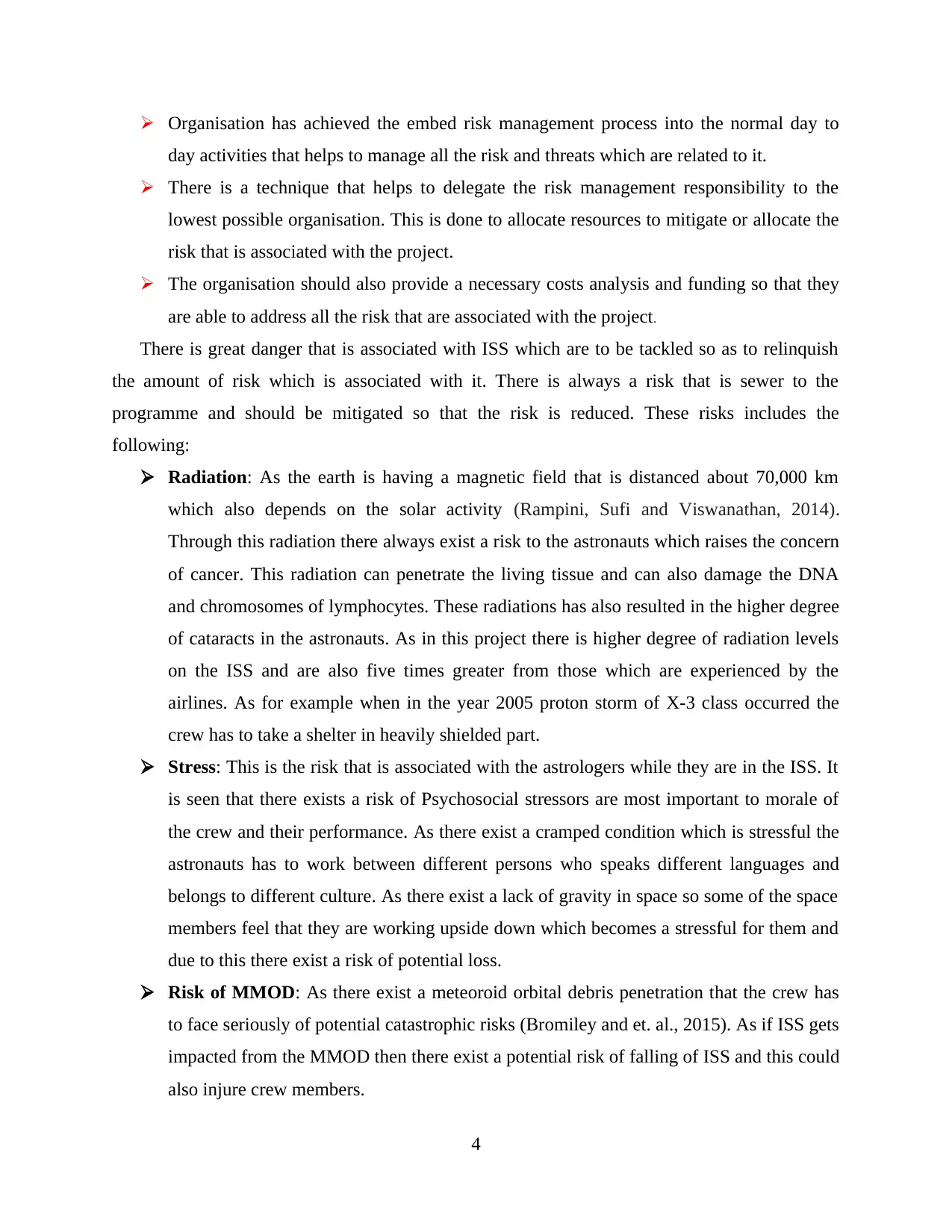
Organisation has achieved the embed risk management process into the normal day to
day activities that helps to manage all the risk and threats which are related to it.
There is a technique that helps to delegate the risk management responsibility to the
lowest possible organisation. This is done to allocate resources to mitigate or allocate the
risk that is associated with the project.
The organisation should also provide a necessary costs analysis and funding so that they
are able to address all the risk that are associated with the project.
There is great danger that is associated with ISS which are to be tackled so as to relinquish
the amount of risk which is associated with it. There is always a risk that is sewer to the
programme and should be mitigated so that the risk is reduced. These risks includes the
following:
Radiation: As the earth is having a magnetic field that is distanced about 70,000 km
which also depends on the solar activity (Rampini, Sufi and Viswanathan, 2014).
Through this radiation there always exist a risk to the astronauts which raises the concern
of cancer. This radiation can penetrate the living tissue and can also damage the DNA
and chromosomes of lymphocytes. These radiations has also resulted in the higher degree
of cataracts in the astronauts. As in this project there is higher degree of radiation levels
on the ISS and are also five times greater from those which are experienced by the
airlines. As for example when in the year 2005 proton storm of X-3 class occurred the
crew has to take a shelter in heavily shielded part.
Stress: This is the risk that is associated with the astrologers while they are in the ISS. It
is seen that there exists a risk of Psychosocial stressors are most important to morale of
the crew and their performance. As there exist a cramped condition which is stressful the
astronauts has to work between different persons who speaks different languages and
belongs to different culture. As there exist a lack of gravity in space so some of the space
members feel that they are working upside down which becomes a stressful for them and
due to this there exist a risk of potential loss.
Risk of MMOD: As there exist a meteoroid orbital debris penetration that the crew has
to face seriously of potential catastrophic risks (Bromiley and et. al., 2015). As if ISS gets
impacted from the MMOD then there exist a potential risk of falling of ISS and this could
also injure crew members.
4
day activities that helps to manage all the risk and threats which are related to it.
There is a technique that helps to delegate the risk management responsibility to the
lowest possible organisation. This is done to allocate resources to mitigate or allocate the
risk that is associated with the project.
The organisation should also provide a necessary costs analysis and funding so that they
are able to address all the risk that are associated with the project.
There is great danger that is associated with ISS which are to be tackled so as to relinquish
the amount of risk which is associated with it. There is always a risk that is sewer to the
programme and should be mitigated so that the risk is reduced. These risks includes the
following:
Radiation: As the earth is having a magnetic field that is distanced about 70,000 km
which also depends on the solar activity (Rampini, Sufi and Viswanathan, 2014).
Through this radiation there always exist a risk to the astronauts which raises the concern
of cancer. This radiation can penetrate the living tissue and can also damage the DNA
and chromosomes of lymphocytes. These radiations has also resulted in the higher degree
of cataracts in the astronauts. As in this project there is higher degree of radiation levels
on the ISS and are also five times greater from those which are experienced by the
airlines. As for example when in the year 2005 proton storm of X-3 class occurred the
crew has to take a shelter in heavily shielded part.
Stress: This is the risk that is associated with the astrologers while they are in the ISS. It
is seen that there exists a risk of Psychosocial stressors are most important to morale of
the crew and their performance. As there exist a cramped condition which is stressful the
astronauts has to work between different persons who speaks different languages and
belongs to different culture. As there exist a lack of gravity in space so some of the space
members feel that they are working upside down which becomes a stressful for them and
due to this there exist a risk of potential loss.
Risk of MMOD: As there exist a meteoroid orbital debris penetration that the crew has
to face seriously of potential catastrophic risks (Bromiley and et. al., 2015). As if ISS gets
impacted from the MMOD then there exist a potential risk of falling of ISS and this could
also injure crew members.
4
⊘ This is a preview!⊘
Do you want full access?
Subscribe today to unlock all pages.

Trusted by 1+ million students worldwide
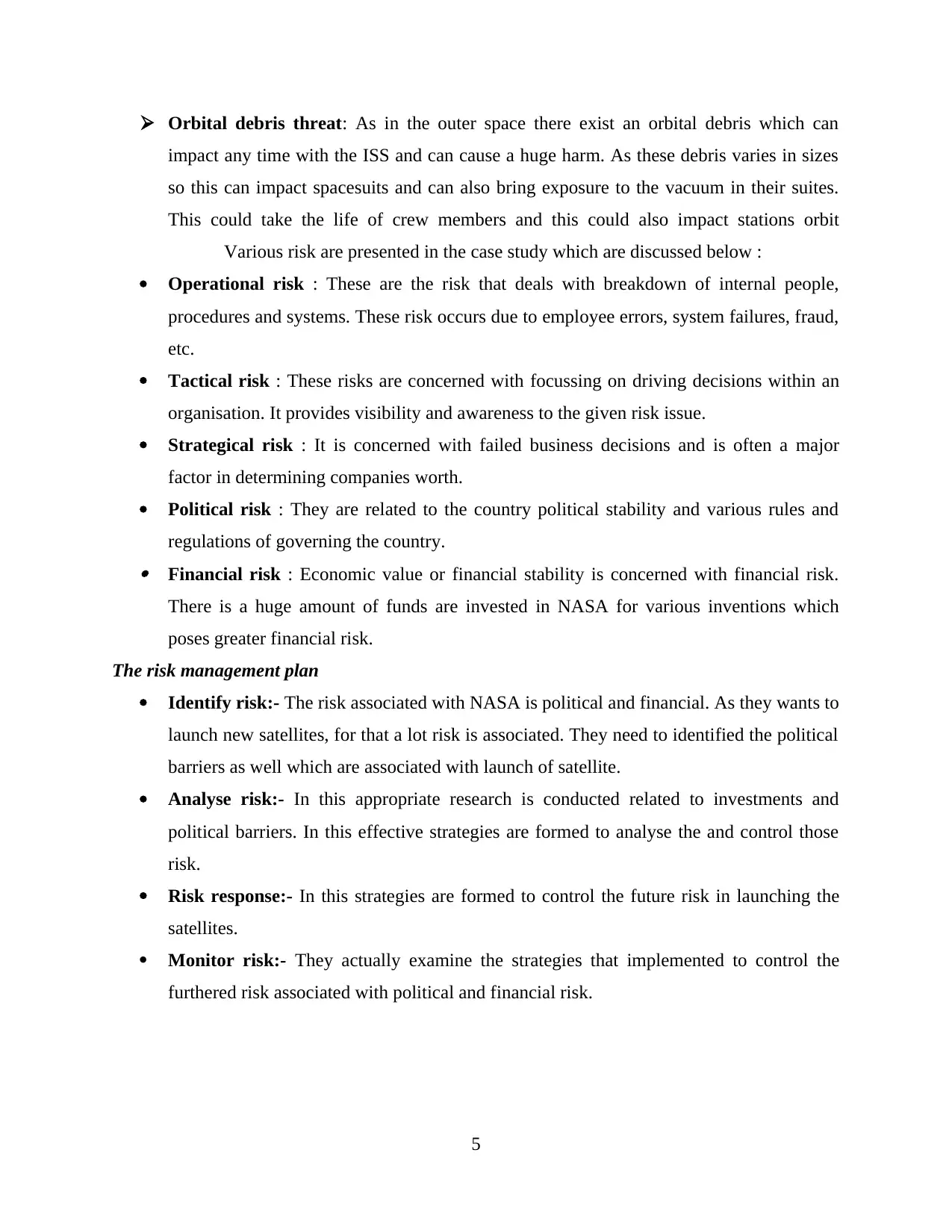
Orbital debris threat: As in the outer space there exist an orbital debris which can
impact any time with the ISS and can cause a huge harm. As these debris varies in sizes
so this can impact spacesuits and can also bring exposure to the vacuum in their suites.
This could take the life of crew members and this could also impact stations orbit
Various risk are presented in the case study which are discussed below :
Operational risk : These are the risk that deals with breakdown of internal people,
procedures and systems. These risk occurs due to employee errors, system failures, fraud,
etc.
Tactical risk : These risks are concerned with focussing on driving decisions within an
organisation. It provides visibility and awareness to the given risk issue.
Strategical risk : It is concerned with failed business decisions and is often a major
factor in determining companies worth.
Political risk : They are related to the country political stability and various rules and
regulations of governing the country. Financial risk : Economic value or financial stability is concerned with financial risk.
There is a huge amount of funds are invested in NASA for various inventions which
poses greater financial risk.
The risk management plan
Identify risk:- The risk associated with NASA is political and financial. As they wants to
launch new satellites, for that a lot risk is associated. They need to identified the political
barriers as well which are associated with launch of satellite.
Analyse risk:- In this appropriate research is conducted related to investments and
political barriers. In this effective strategies are formed to analyse the and control those
risk.
Risk response:- In this strategies are formed to control the future risk in launching the
satellites.
Monitor risk:- They actually examine the strategies that implemented to control the
furthered risk associated with political and financial risk.
5
impact any time with the ISS and can cause a huge harm. As these debris varies in sizes
so this can impact spacesuits and can also bring exposure to the vacuum in their suites.
This could take the life of crew members and this could also impact stations orbit
Various risk are presented in the case study which are discussed below :
Operational risk : These are the risk that deals with breakdown of internal people,
procedures and systems. These risk occurs due to employee errors, system failures, fraud,
etc.
Tactical risk : These risks are concerned with focussing on driving decisions within an
organisation. It provides visibility and awareness to the given risk issue.
Strategical risk : It is concerned with failed business decisions and is often a major
factor in determining companies worth.
Political risk : They are related to the country political stability and various rules and
regulations of governing the country. Financial risk : Economic value or financial stability is concerned with financial risk.
There is a huge amount of funds are invested in NASA for various inventions which
poses greater financial risk.
The risk management plan
Identify risk:- The risk associated with NASA is political and financial. As they wants to
launch new satellites, for that a lot risk is associated. They need to identified the political
barriers as well which are associated with launch of satellite.
Analyse risk:- In this appropriate research is conducted related to investments and
political barriers. In this effective strategies are formed to analyse the and control those
risk.
Risk response:- In this strategies are formed to control the future risk in launching the
satellites.
Monitor risk:- They actually examine the strategies that implemented to control the
furthered risk associated with political and financial risk.
5
Paraphrase This Document
Need a fresh take? Get an instant paraphrase of this document with our AI Paraphraser
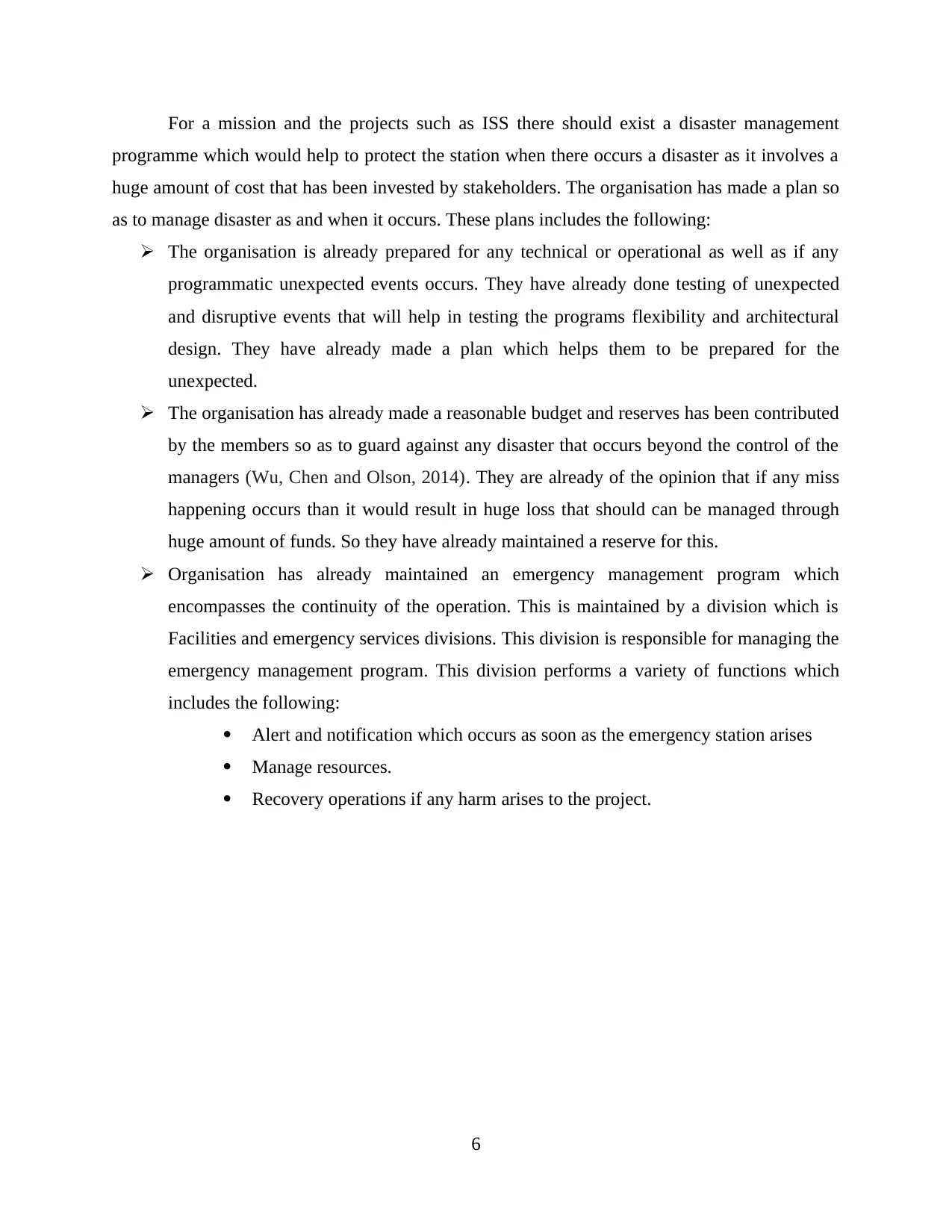
For a mission and the projects such as ISS there should exist a disaster management
programme which would help to protect the station when there occurs a disaster as it involves a
huge amount of cost that has been invested by stakeholders. The organisation has made a plan so
as to manage disaster as and when it occurs. These plans includes the following:
The organisation is already prepared for any technical or operational as well as if any
programmatic unexpected events occurs. They have already done testing of unexpected
and disruptive events that will help in testing the programs flexibility and architectural
design. They have already made a plan which helps them to be prepared for the
unexpected.
The organisation has already made a reasonable budget and reserves has been contributed
by the members so as to guard against any disaster that occurs beyond the control of the
managers (Wu, Chen and Olson, 2014). They are already of the opinion that if any miss
happening occurs than it would result in huge loss that should can be managed through
huge amount of funds. So they have already maintained a reserve for this.
Organisation has already maintained an emergency management program which
encompasses the continuity of the operation. This is maintained by a division which is
Facilities and emergency services divisions. This division is responsible for managing the
emergency management program. This division performs a variety of functions which
includes the following:
Alert and notification which occurs as soon as the emergency station arises
Manage resources.
Recovery operations if any harm arises to the project.
6
programme which would help to protect the station when there occurs a disaster as it involves a
huge amount of cost that has been invested by stakeholders. The organisation has made a plan so
as to manage disaster as and when it occurs. These plans includes the following:
The organisation is already prepared for any technical or operational as well as if any
programmatic unexpected events occurs. They have already done testing of unexpected
and disruptive events that will help in testing the programs flexibility and architectural
design. They have already made a plan which helps them to be prepared for the
unexpected.
The organisation has already made a reasonable budget and reserves has been contributed
by the members so as to guard against any disaster that occurs beyond the control of the
managers (Wu, Chen and Olson, 2014). They are already of the opinion that if any miss
happening occurs than it would result in huge loss that should can be managed through
huge amount of funds. So they have already maintained a reserve for this.
Organisation has already maintained an emergency management program which
encompasses the continuity of the operation. This is maintained by a division which is
Facilities and emergency services divisions. This division is responsible for managing the
emergency management program. This division performs a variety of functions which
includes the following:
Alert and notification which occurs as soon as the emergency station arises
Manage resources.
Recovery operations if any harm arises to the project.
6
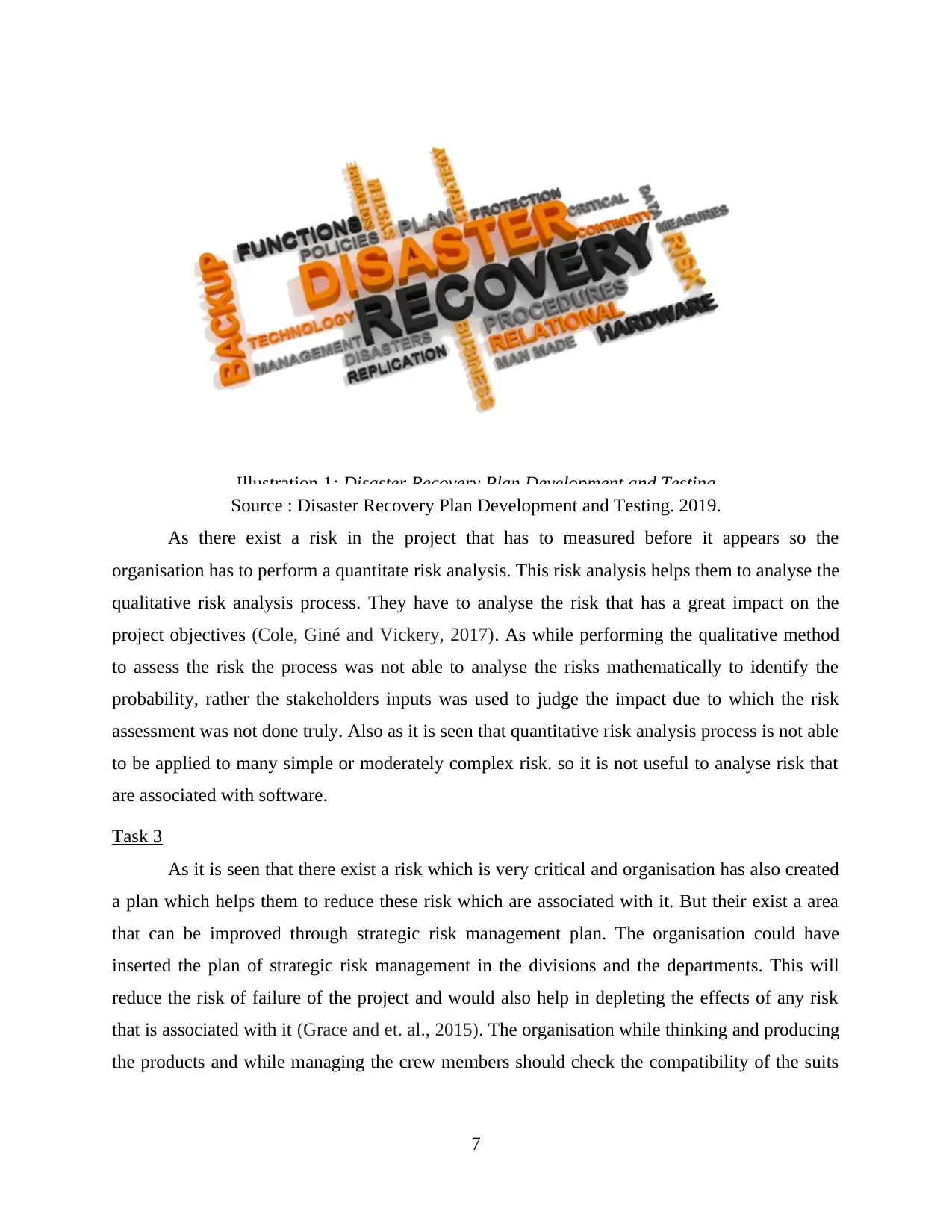
Source : Disaster Recovery Plan Development and Testing. 2019.
As there exist a risk in the project that has to measured before it appears so the
organisation has to perform a quantitate risk analysis. This risk analysis helps them to analyse the
qualitative risk analysis process. They have to analyse the risk that has a great impact on the
project objectives (Cole, Giné and Vickery, 2017). As while performing the qualitative method
to assess the risk the process was not able to analyse the risks mathematically to identify the
probability, rather the stakeholders inputs was used to judge the impact due to which the risk
assessment was not done truly. Also as it is seen that quantitative risk analysis process is not able
to be applied to many simple or moderately complex risk. so it is not useful to analyse risk that
are associated with software.
Task 3
As it is seen that there exist a risk which is very critical and organisation has also created
a plan which helps them to reduce these risk which are associated with it. But their exist a area
that can be improved through strategic risk management plan. The organisation could have
inserted the plan of strategic risk management in the divisions and the departments. This will
reduce the risk of failure of the project and would also help in depleting the effects of any risk
that is associated with it (Grace and et. al., 2015). The organisation while thinking and producing
the products and while managing the crew members should check the compatibility of the suits
7
Illustration 1: Disaster Recovery Plan Development and Testing
As there exist a risk in the project that has to measured before it appears so the
organisation has to perform a quantitate risk analysis. This risk analysis helps them to analyse the
qualitative risk analysis process. They have to analyse the risk that has a great impact on the
project objectives (Cole, Giné and Vickery, 2017). As while performing the qualitative method
to assess the risk the process was not able to analyse the risks mathematically to identify the
probability, rather the stakeholders inputs was used to judge the impact due to which the risk
assessment was not done truly. Also as it is seen that quantitative risk analysis process is not able
to be applied to many simple or moderately complex risk. so it is not useful to analyse risk that
are associated with software.
Task 3
As it is seen that there exist a risk which is very critical and organisation has also created
a plan which helps them to reduce these risk which are associated with it. But their exist a area
that can be improved through strategic risk management plan. The organisation could have
inserted the plan of strategic risk management in the divisions and the departments. This will
reduce the risk of failure of the project and would also help in depleting the effects of any risk
that is associated with it (Grace and et. al., 2015). The organisation while thinking and producing
the products and while managing the crew members should check the compatibility of the suits
7
Illustration 1: Disaster Recovery Plan Development and Testing
⊘ This is a preview!⊘
Do you want full access?
Subscribe today to unlock all pages.

Trusted by 1+ million students worldwide
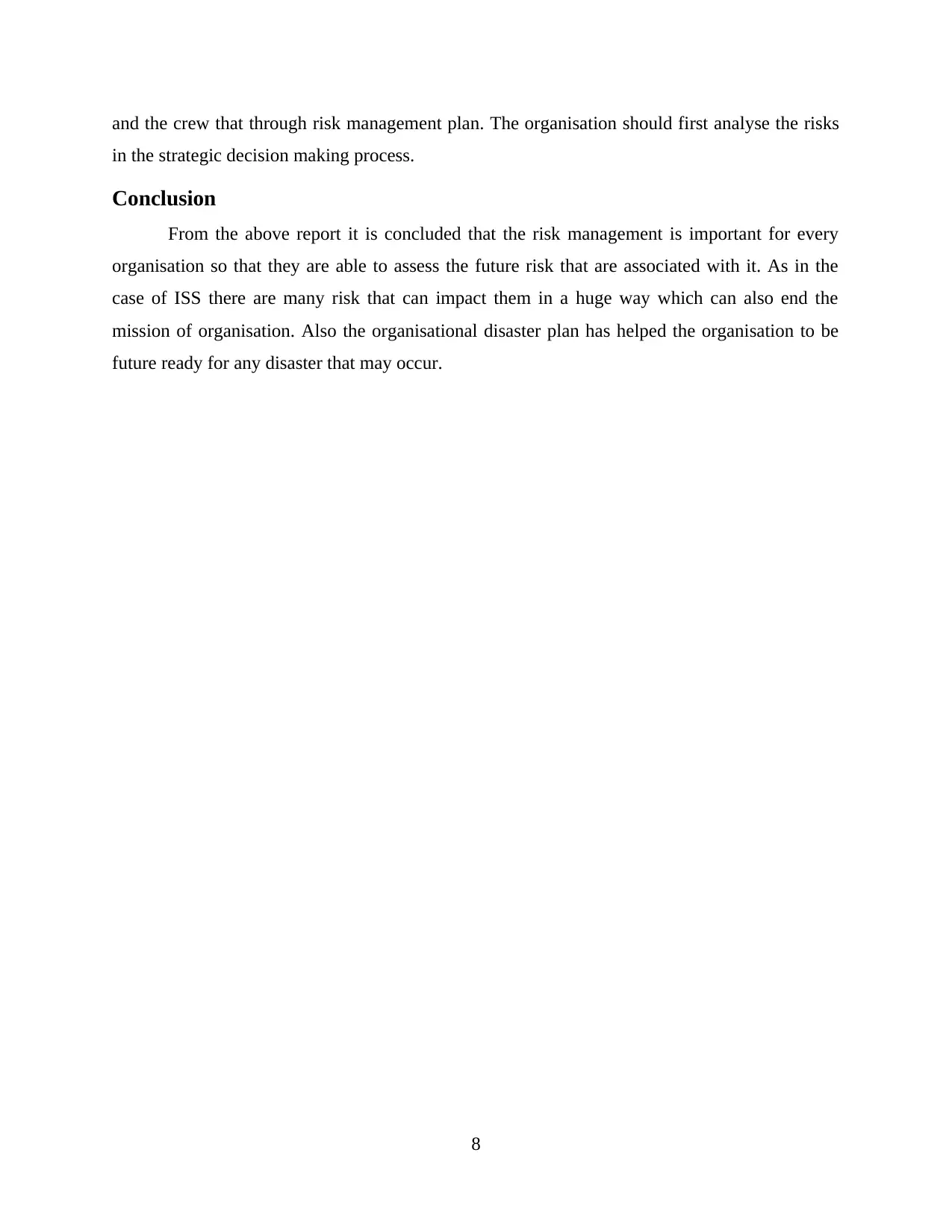
and the crew that through risk management plan. The organisation should first analyse the risks
in the strategic decision making process.
Conclusion
From the above report it is concluded that the risk management is important for every
organisation so that they are able to assess the future risk that are associated with it. As in the
case of ISS there are many risk that can impact them in a huge way which can also end the
mission of organisation. Also the organisational disaster plan has helped the organisation to be
future ready for any disaster that may occur.
8
in the strategic decision making process.
Conclusion
From the above report it is concluded that the risk management is important for every
organisation so that they are able to assess the future risk that are associated with it. As in the
case of ISS there are many risk that can impact them in a huge way which can also end the
mission of organisation. Also the organisational disaster plan has helped the organisation to be
future ready for any disaster that may occur.
8
Paraphrase This Document
Need a fresh take? Get an instant paraphrase of this document with our AI Paraphraser
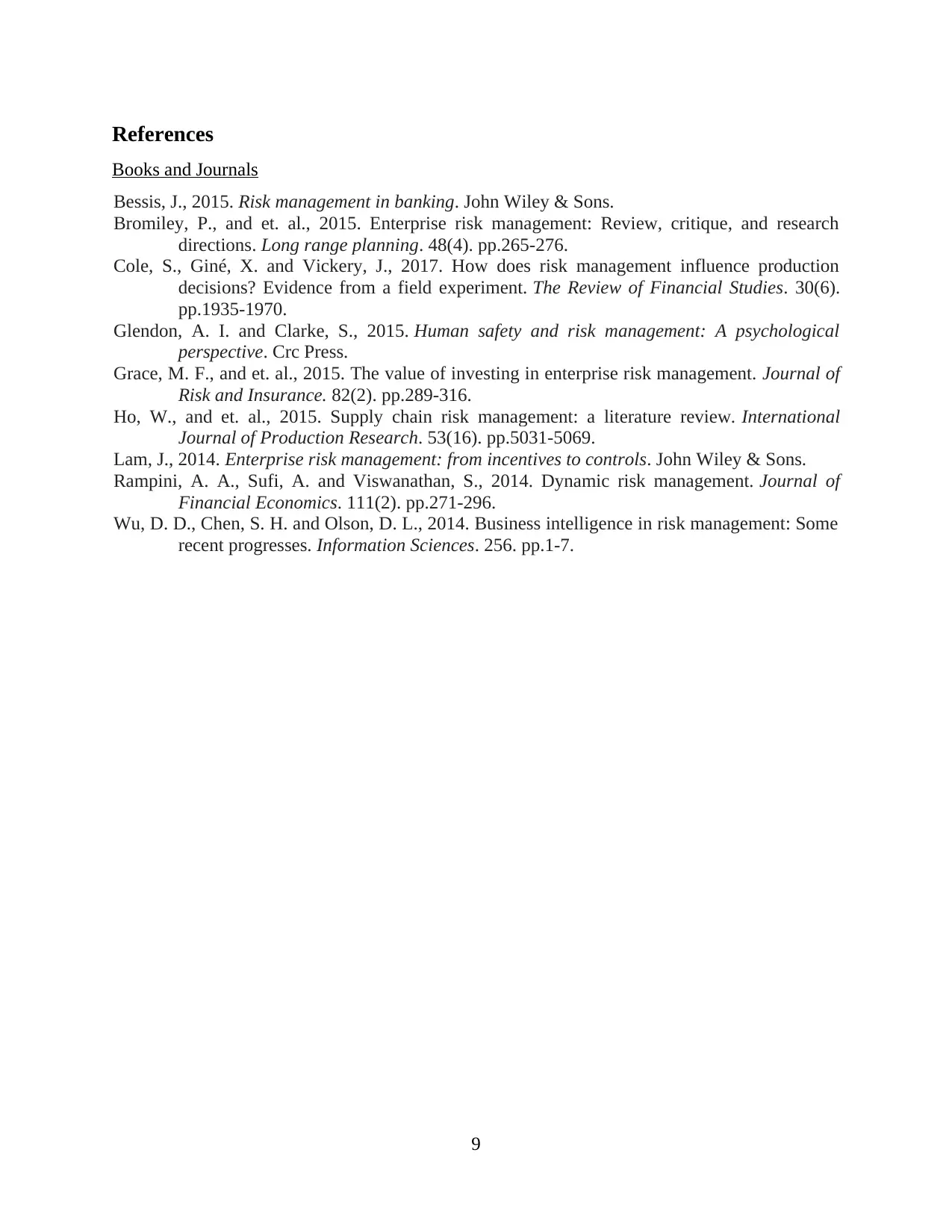
References
Books and Journals
Bessis, J., 2015. Risk management in banking. John Wiley & Sons.
Bromiley, P., and et. al., 2015. Enterprise risk management: Review, critique, and research
directions. Long range planning. 48(4). pp.265-276.
Cole, S., Giné, X. and Vickery, J., 2017. How does risk management influence production
decisions? Evidence from a field experiment. The Review of Financial Studies. 30(6).
pp.1935-1970.
Glendon, A. I. and Clarke, S., 2015. Human safety and risk management: A psychological
perspective. Crc Press.
Grace, M. F., and et. al., 2015. The value of investing in enterprise risk management. Journal of
Risk and Insurance. 82(2). pp.289-316.
Ho, W., and et. al., 2015. Supply chain risk management: a literature review. International
Journal of Production Research. 53(16). pp.5031-5069.
Lam, J., 2014. Enterprise risk management: from incentives to controls. John Wiley & Sons.
Rampini, A. A., Sufi, A. and Viswanathan, S., 2014. Dynamic risk management. Journal of
Financial Economics. 111(2). pp.271-296.
Wu, D. D., Chen, S. H. and Olson, D. L., 2014. Business intelligence in risk management: Some
recent progresses. Information Sciences. 256. pp.1-7.
9
Books and Journals
Bessis, J., 2015. Risk management in banking. John Wiley & Sons.
Bromiley, P., and et. al., 2015. Enterprise risk management: Review, critique, and research
directions. Long range planning. 48(4). pp.265-276.
Cole, S., Giné, X. and Vickery, J., 2017. How does risk management influence production
decisions? Evidence from a field experiment. The Review of Financial Studies. 30(6).
pp.1935-1970.
Glendon, A. I. and Clarke, S., 2015. Human safety and risk management: A psychological
perspective. Crc Press.
Grace, M. F., and et. al., 2015. The value of investing in enterprise risk management. Journal of
Risk and Insurance. 82(2). pp.289-316.
Ho, W., and et. al., 2015. Supply chain risk management: a literature review. International
Journal of Production Research. 53(16). pp.5031-5069.
Lam, J., 2014. Enterprise risk management: from incentives to controls. John Wiley & Sons.
Rampini, A. A., Sufi, A. and Viswanathan, S., 2014. Dynamic risk management. Journal of
Financial Economics. 111(2). pp.271-296.
Wu, D. D., Chen, S. H. and Olson, D. L., 2014. Business intelligence in risk management: Some
recent progresses. Information Sciences. 256. pp.1-7.
9
1 out of 11
Related Documents
Your All-in-One AI-Powered Toolkit for Academic Success.
+13062052269
info@desklib.com
Available 24*7 on WhatsApp / Email
![[object Object]](/_next/static/media/star-bottom.7253800d.svg)
Unlock your academic potential
Copyright © 2020–2025 A2Z Services. All Rights Reserved. Developed and managed by ZUCOL.




